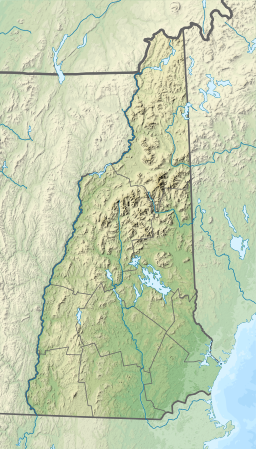| Grafton Pond | |
|---|---|
 | |
| Location | Grafton County, New Hampshire |
| Coordinates | 43°34′42″N 72°2′15″W / 43.57833°N 72.03750°W |
| Primary outflows | tributary of Bicknell Brook |
| Basin countries | United States |
| Max. length | 1.5 mi (2.4 km) |
| Max. width | 0.7 mi (1.1 km) |
| Surface area | 319 acres (1.3 km2) |
| Average depth | 13 ft (4.0 m) |
| Max. depth | 72 ft (22 m) |
| Surface elevation | 1,224 ft (373 m) |
| Islands | at least 29 |
| Settlements | Grafton |
Grafton Pond is a 319-acre (1.3 km2)[1] water body located in Grafton County in western New Hampshire, United States, in the town of Grafton. The pond is part of the Mascoma River watershed, flowing to the Connecticut River. Outflow from the pond travels through Bicknell Brook to Crystal Lake in Enfield, then north to the Mascoma River in West Canaan.
Grafton Pond is located within the Society for the Protection of New Hampshire Forests' Grafton Pond Reservation and is an active common loon nesting site. There is a cement dam with a spillway for the pond leading into Bicknell Brook. It is a local favorite for swimming, fishing and boating, although only electric engines are allowed on the pond. No camping or campfires are allowed around the pond or on any of the islands, and it is a "carry in, carry out" area.
The lake is classified as a warmwater fishery, with observed species including smallmouth bass, chain pickerel, yellow perch, sunfish, and brown bullhead,[1] as well as largemouth bass.
See also
[edit]References
[edit]- ^ a b "Grafton Pond, Grafton" (PDF). NH Fish & Game. Retrieved August 15, 2014.
External links
[edit]


Well, that’s interesting to know that Psilotum nudum are known as whisk ferns. Psilotum nudum is the commoner species of the two. While the P. flaccidum is a rare species and is found in the tropical islands. Both the species are usually epiphytic in habit and grow upon tree ferns. These species may also be terrestrial and grow in humus or in the crevices of the rocks.
View the detailed Guide of Psilotum nudum: Detailed Study Of Psilotum Nudum (Whisk Fern), Classification, Anatomy, Reproduction